Attached files
| file | filename |
|---|---|
| 8-K - 8-K - TRINITY INDUSTRIES INC | a080618q2investorpresentat.htm |
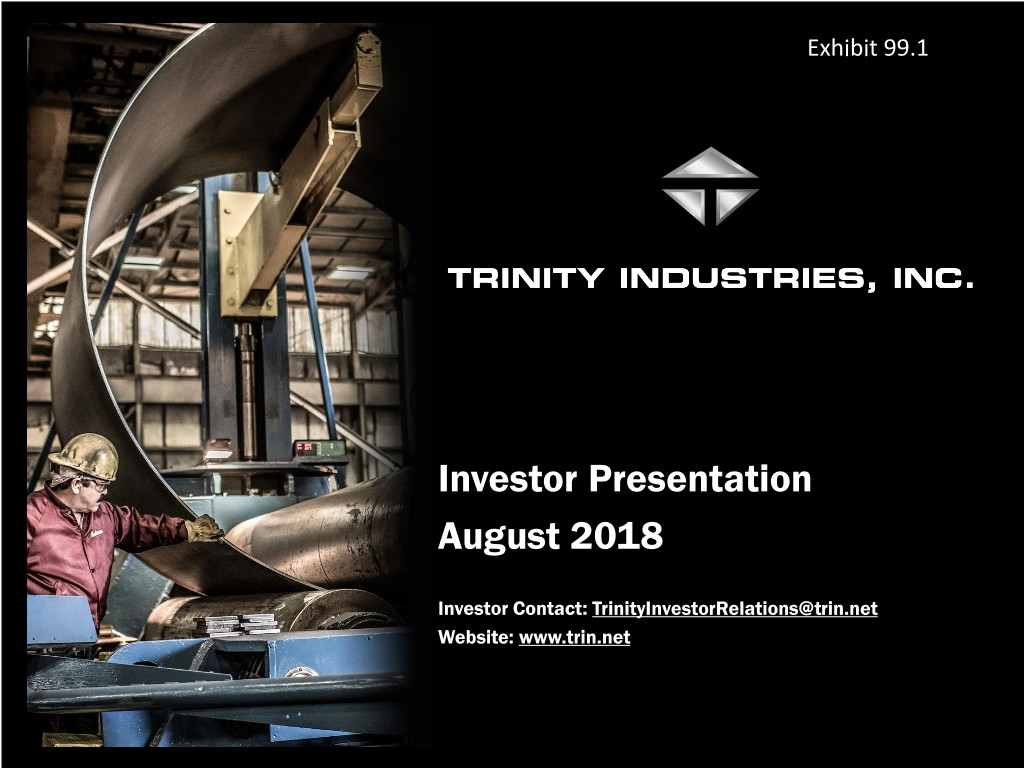
Exhibit 99.1 Investor Presentation August 2018 Investor Contact: TrinityInvestorRelations@trin.net Website: www.trin.net

Forward Looking Statements Some statements in this presentation, which are not historical facts, are “forward-looking statements” as defined by the Private Securities Litigation Reform Act of 1995. Forward-looking statements include statements about Trinity's estimates, expectations, beliefs, intentions or strategies for the future, and the assumptions underlying these forward-looking statements, including, but not limited to, statements regarding the effect of The Tax Cuts and Jobs Act on Trinity's financial results, any non-cash tax benefits from the remeasurement of Trinity's net deferred tax liabilities, the anticipated separation of Trinity into two separate public companies, the expected timetable for completing the spin-off transaction, whether or not the spin-off transaction occurs, future financial and operating performance of each company, benefits and synergies of the spin-off transaction, strategic and competitive advantages of each company, future opportunities for each company and any other statements regarding events or developments that Trinity believes or anticipates will or may occur in the future. Trinity uses the words “anticipates,” “assumes,” “believes,” “estimates,” “expects,” “intends,” “forecasts,” “may,” “will,” “should,” “guidance,” “outlook,” and similar expressions to identify these forward-looking statements. Forward-looking statements speak only as of the date of this presentation, and, except as required by federal securities laws, Trinity expressly disclaims any obligation or undertaking to disseminate any updates or revisions to any forward-looking statement contained herein to reflect any change in Trinity’s expectations with regard thereto or any change in events, conditions or circumstances on which any such statement is based. There is no assurance that the proposed spin-off transaction will be completed, that the Company's Board of Directors will continue to pursue the proposed spin-off transaction (even if there are no impediments to completion), that the Company will be able to separate its businesses, or that the proposed spin-off transaction will be the most beneficial alternative considered. Forward looking statements involve risks and uncertainties that could cause actual results to differ materially from historical experience or our present expectations, including but not limited to risks and uncertainties regarding economic, competitive, governmental, and technological factors affecting Trinity’s operations, markets, products, services and prices, as well as any changes in or abandonment of the proposed separation or the ability to effect the separation and satisfy the conditions to the proposed separation, and such forward-looking statements are not guarantees of future performance. For a discussion of such risks and uncertainties, which could cause actual results to differ from those contained in the forward-looking statements, see “Risk Factors” and “Forward-Looking Statements” in the Company's Annual Report on Form 10-K for the most recent fiscal year, and as may be revised and updated by our Quarterly Reports on Form 10-Q and Current Reports on Form 8-K. 2

Agenda I. Trinity Industries, Inc. Overview Today II. Overview and Rationale for Planned Spin-off III. Spin-off Timeline and Progress Report IV. Appendix 3
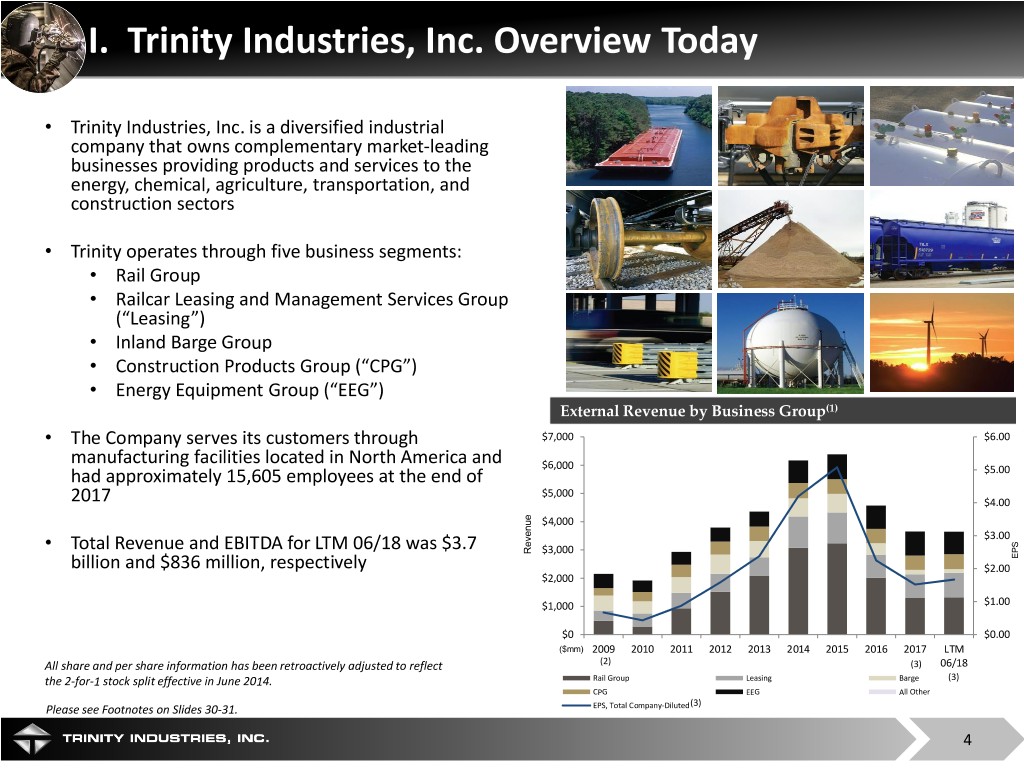
I. Trinity Industries, Inc. Overview Today • Trinity Industries, Inc. is a diversified industrial company that owns complementary market-leading businesses providing products and services to the energy, chemical, agriculture, transportation, and construction sectors • Trinity operates through five business segments: • Rail Group • Railcar Leasing and Management Services Group (“Leasing”) • Inland Barge Group • Construction Products Group (“CPG”) • Energy Equipment Group (“EEG”) External Revenue by Business Group(1) • The Company serves its customers through $7,000 $6.00 manufacturing facilities located in North America and $6,000 had approximately 15,605 employees at the end of $5.00 $5,000 2017 $4.00 $4,000 • $3.00 Total Revenue and EBITDA for LTM 06/18 was $3.7 Revenue $3,000 EPS billion and $836 million, respectively $2.00 $2,000 $1,000 $1.00 $0 $0.00 ($mm) 2009 2010 2011 2012 2013 2014 2015 2016 2017 LTM All share and per share information has been retroactively adjusted to reflect (2) (3) 06/18 the 2-for-1 stock split effective in June 2014. Rail Group Leasing Barge (3) CPG EEG All Other (3) Please see Footnotes on Slides 30-31. EPS, Total Company-Diluted 4

Leading Market Positions in North America Rail Group Leading manufacturer of railcars Leading manufacturer of railcar axles Leading manufacturer of railcar coupling devices Railcar Leasing and Leading provider of railcar leasing and management Management Services services Group Inland Barge Group Leading manufacturer of inland barges and fiberglass barge covers in the United States Construction Products Leading full-line manufacturer of highway guardrail and Group crash cushions in the United States Leading producer and distributor of lightweight and natural construction aggregates in certain regions in the United States Leading manufacturer of structural wind towers Energy Equipment Group Leading manufacturer of storage and distribution containers and tank heads for pressure and non- pressure vessels Leading manufacturer of steel utility structures for electricity transmission and distribution 5
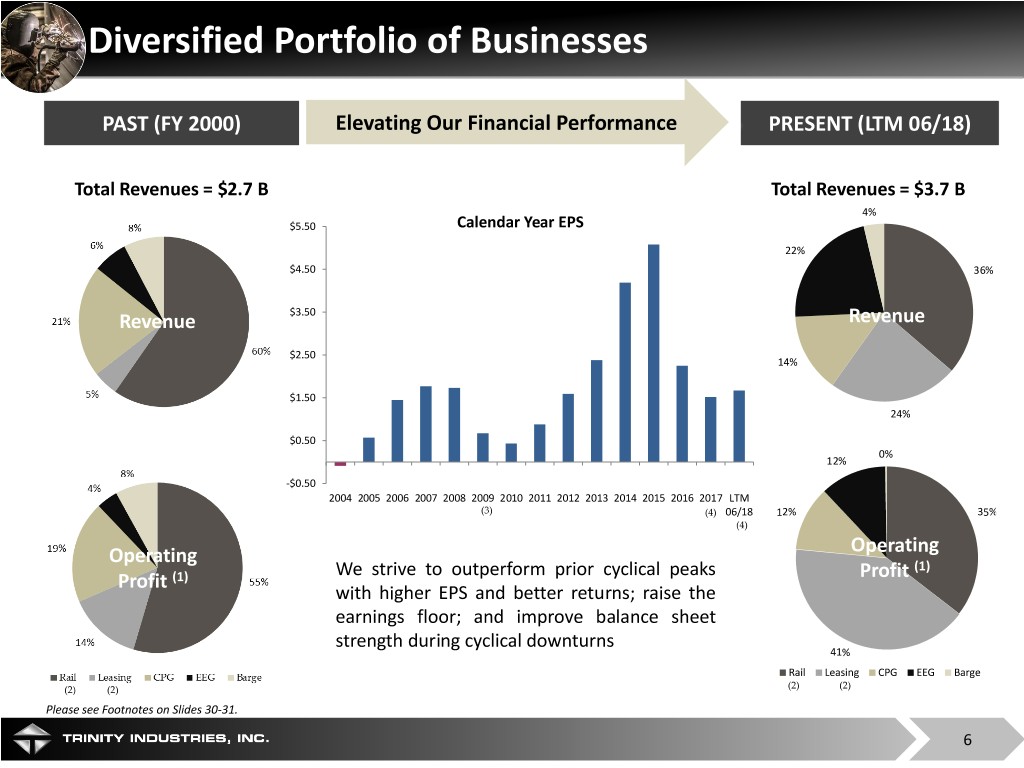
Diversified Portfolio of Businesses PAST (FY 2000) Elevating Our Financial Performance PRESENT (LTM 06/18) Total Revenues = $2.7 B Total Revenues = $3.7 B 4% $5.50 Calendar Year EPS 22% $4.50 36% Revenue $3.50 Revenue $2.50 14% $1.50 24% $0.50 0% 12% -$0.50 2004 2005 2006 2007 2008 2009 2010 2011 2012 2013 2014 2015 2016 2017 LTM (3) (4) 06/18 12% 35% (4) Operating Operating We strive to outperform prior cyclical peaks Profit (1) Profit (1) with higher EPS and better returns; raise the earnings floor; and improve balance sheet strength during cyclical downturns 41% Rail Leasing CPG EEG Barge (2) (2) (2) (2) Please see Footnotes on Slides 30-31. 6

Flexible and Cost-Effective Manufacturing Flexibility Trinity's manufacturing flexibility across products enhances our ability to opportunistically respond to changes in market demand Cost-Effective Trinity’s manufacturing scale, vertical integration, and presence in the Southern U.S. and Mexico provide cost effective benefits across multiple business segments In recent years, Trinity has invested significantly in its manufacturing footprint, establishing a strong manufacturing platform and ability to respond to changes in market demand 7

Seasoned Performer Across Market Conditions . Incorporated in 1933 with a strong corporate culture and commitment to Company values . Seasoned management team knows how to assess the market, proactively plan for cycles and quickly adapt to changing market conditions . Cost-effective and flexible manufacturing footprint is a competitive advantage for many of our product lines . Significant liquidity position and a strong balance sheet at quarter end June 30, 2018 . Track record of maintaining a healthy liquidity position across the business cycle 8
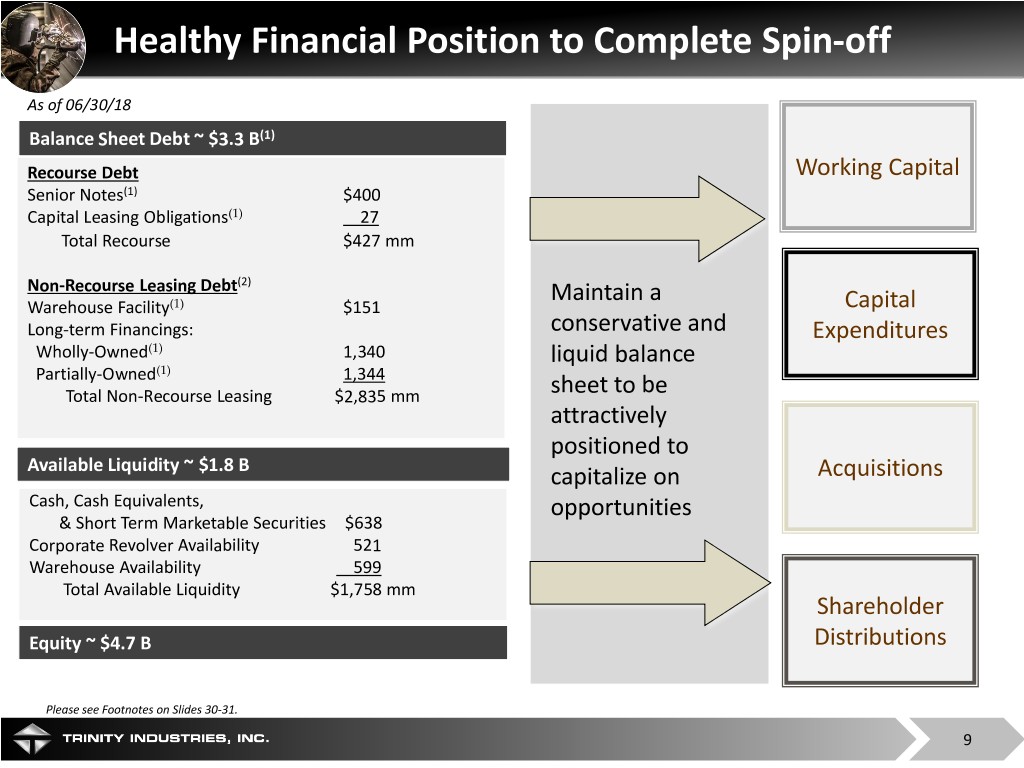
Healthy Financial Position to Complete Spin-off As of 06/30/18 Balance Sheet Debt ~ $3.3 B(1) Recourse Debt Working Capital Senior Notes(1) $400 Capital Leasing Obligations(1) 27 Total Recourse $427 mm Non-Recourse Leasing Debt(2) Maintain a Warehouse Facility(1) $151 Capital Long-term Financings: conservative and Expenditures Wholly-Owned(1) 1,340 liquid balance Partially-Owned(1) 1,344 Total Non-Recourse Leasing $2,835 mm sheet to be attractively positioned to Available Liquidity ~ $1.8 B capitalize on Acquisitions Cash, Cash Equivalents, opportunities & Short Term Marketable Securities $638 Corporate Revolver Availability 521 Warehouse Availability 599 Total Available Liquidity $1,758 mm Shareholder Equity ~ $4.7 B Distributions Please see Footnotes on Slides 30-31. 9

Financial Highlights Trinity’s EPS Summary FY 2009 – LTM 06/18(3) LTM 06/18 vs. LTM 06/17(1) $6.00 . Revenues decreased 8.8% to $3.65 billion from $4.00 $5.08 $5.00 billion $4.19 $4.00 . Operating profit decreased 16.9% to $393.6 million from (2) $3.00 $473.8 million $2.38 $2.25 . EBITDA decreased 6.1% to $835.6 million from $889.7 $2.00 $1.59 $1.52 $1.67 $0.88 $0.67 million $1.00 $0.43 . Earnings per common diluted share increased 3.1% to $0.00 (5) 2009 2010 2011 2012 2013 2014 2015 2016 2017 LTM $1.67 from $1.62 per diluted share (4) (5) 06/18 (5) Trinity’s EBITDA Summary FY 2009 – LTM 06/18(6) $449.3 million Convertible Subordinated Notes (“Notes”) $1,800 $1,713 On April 23, 2018, as previously disclosed, the Company gave $1,600 notice of its election to redeem all of the Notes on June 1, 2018 $1,502 at a redemption price in cash equal to 100% of the principal $1,400 $1,200 amount. As a result, holders of the entire par amount, excluding $989 $1,032 $1,000 $0.8 million, submitted notices for conversion. The Company $851 $836 elected to settle the conversions in cash rather than in shares of $800 $774 $612 common stock or a combination of cash and shares of common $600 $470 $443 stock. As of July 3, 2018, the Company had completed $400 conversion settlements for an aggregate cash amount of $646.6 $200 million. For more details, please refer to the Company’s Form $0 10-Q filed on July 26, 2018. 2009 2010 2011 2012 2013 2014 2015 2016 2017 LTM 06/18 Please see Footnotes on Slides 30-31. 10
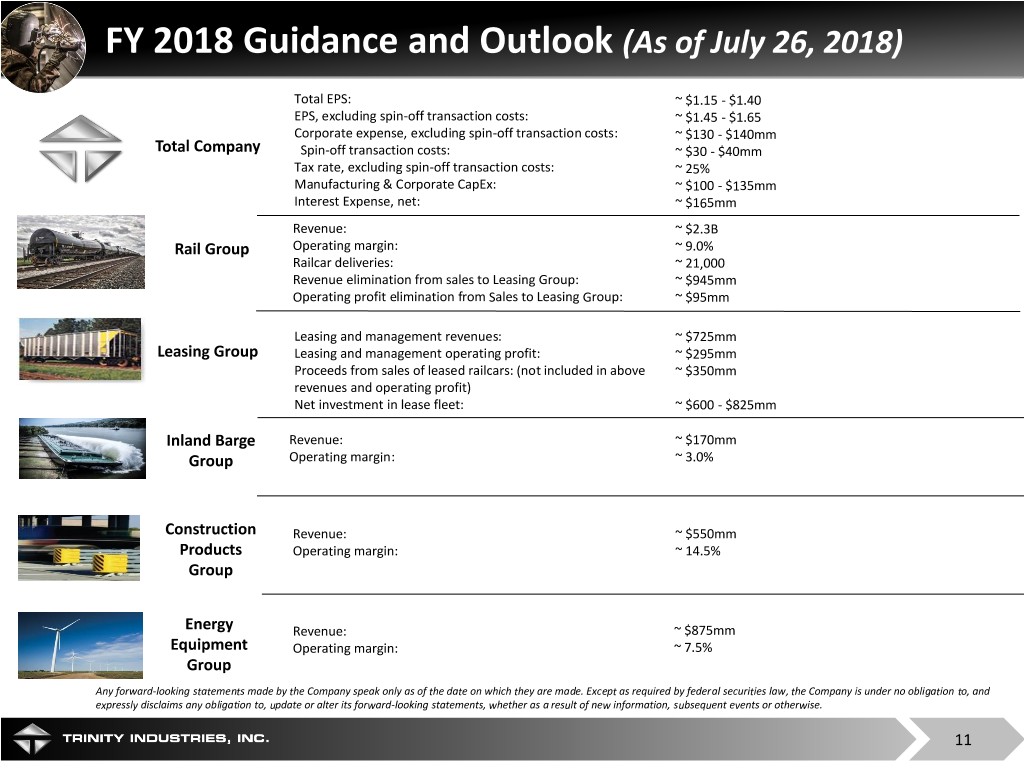
FY 2018 Guidance and Outlook (As of July 26, 2018) Total EPS: ~ $1.15 - $1.40 EPS, excluding spin-off transaction costs: ~ $1.45 - $1.65 Corporate expense, excluding spin-off transaction costs: ~ $130 - $140mm Total Company Spin-off transaction costs: ~ $30 - $40mm Tax rate, excluding spin-off transaction costs: ~ 25% Manufacturing & Corporate CapEx: ~ $100 - $135mm Interest Expense, net: ~ $165mm Revenue: ~ $2.3B Rail Group Operating margin: ~ 9.0% Railcar deliveries: ~ 21,000 Revenue elimination from sales to Leasing Group: ~ $945mm Operating profit elimination from Sales to Leasing Group: ~ $95mm Leasing and management revenues: ~ $725mm Leasing Group Leasing and management operating profit: ~ $295mm Proceeds from sales of leased railcars: (not included in above ~ $350mm revenues and operating profit) Net investment in lease fleet: ~ $600 - $825mm Inland Barge Revenue: ~ $170mm Group Operating margin: ~ 3.0% Construction Revenue: ~ $550mm Products Operating margin: ~ 14.5% Group Energy Revenue: ~ $875mm Equipment Operating margin: ~ 7.5% Group Any forward-looking statements made by the Company speak only as of the date on which they are made. Except as required by federal securities law, the Company is under no obligation to, and expressly disclaims any obligation to, update or alter its forward-looking statements, whether as a result of new information, subsequent events or otherwise. 11

II. Overview and Rationale for Planned Spin-Off 12

Spin-off of Arcosa, Inc. • On December 12, 2017, Trinity Industries announced a plan to pursue the spin-off of its infrastructure-related businesses to shareholders • Trinity introduced Arcosa, Inc. as the new company in an initial Form 10 filing on May 15, 2018 and filed subsequent amendments on June 15 and August 1, providing additional information • Transaction is expected to result in two separate public companies that will benefit from: – Leading positions in their respective industries – Strong cash flow generation – Compelling growth opportunities • Separation is planned as a tax-free spin-off to shareholders for U.S. federal income tax purposes • Separation is expected to be completed in the fourth quarter of 2018 13
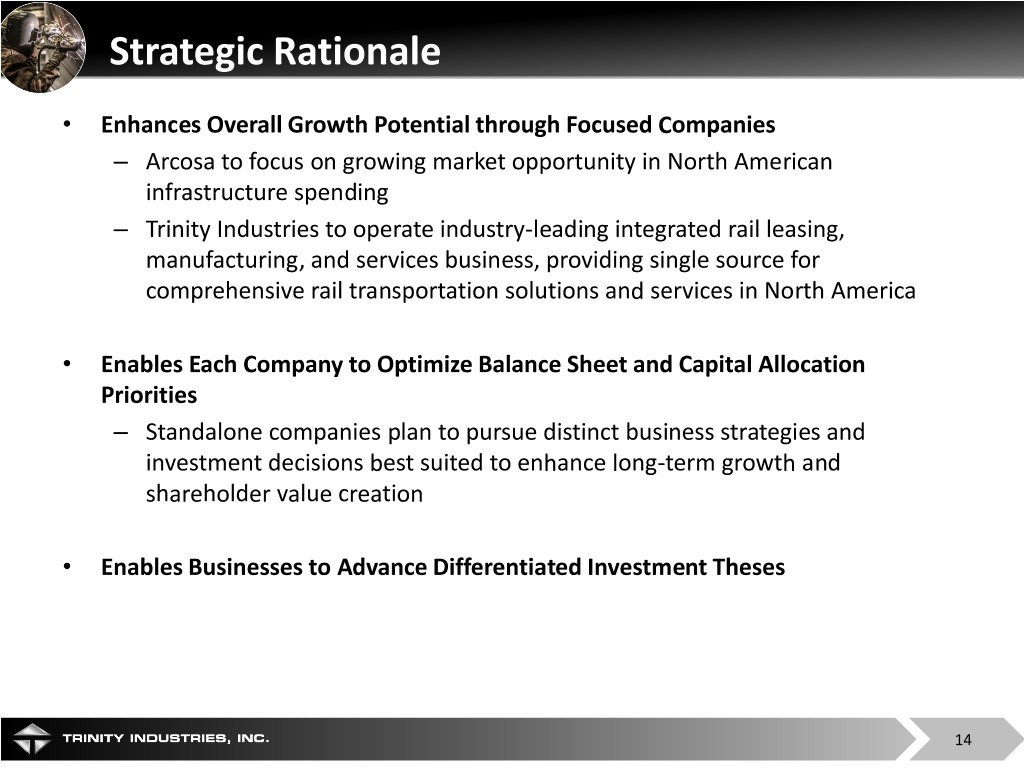
Strategic Rationale • Enhances Overall Growth Potential through Focused Companies – Arcosa to focus on growing market opportunity in North American infrastructure spending – Trinity Industries to operate industry-leading integrated rail leasing, manufacturing, and services business, providing single source for comprehensive rail transportation solutions and services in North America • Enables Each Company to Optimize Balance Sheet and Capital Allocation Priorities – Standalone companies plan to pursue distinct business strategies and investment decisions best suited to enhance long-term growth and shareholder value creation • Enables Businesses to Advance Differentiated Investment Theses 14
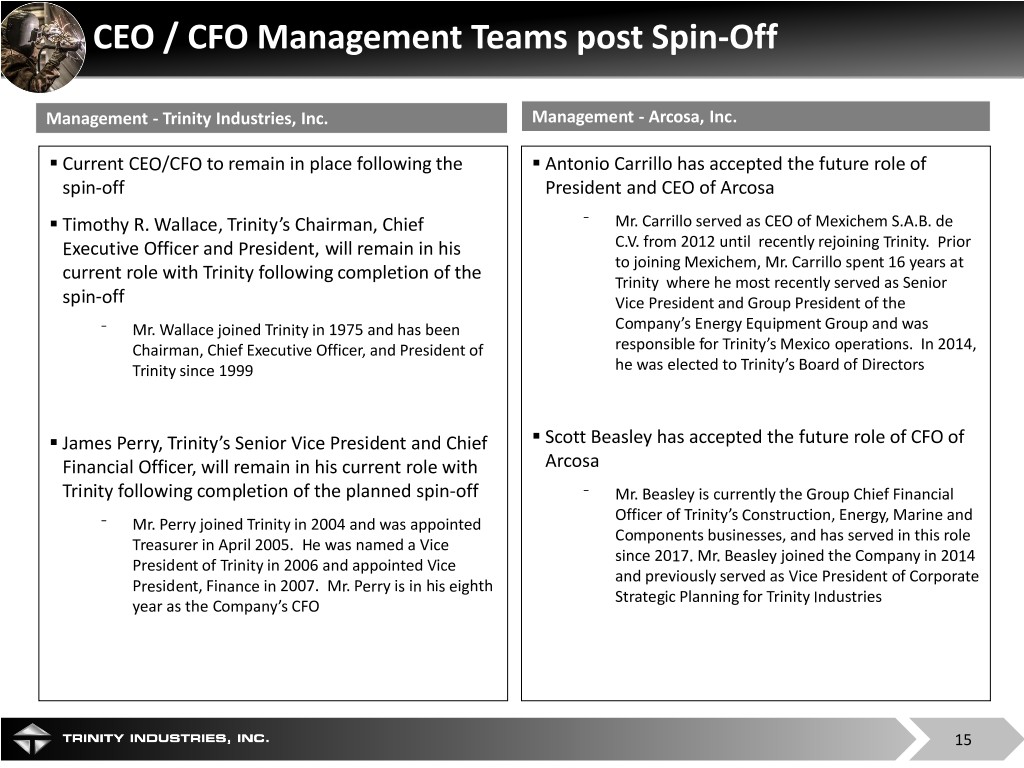
CEO / CFO Management Teams post Spin-Off Management - Trinity Industries, Inc. Management - Arcosa, Inc. . Current CEO/CFO to remain in place following the . Antonio Carrillo has accepted the future role of spin-off President and CEO of Arcosa . Timothy R. Wallace, Trinity’s Chairman, Chief ⁻ Mr. Carrillo served as CEO of Mexichem S.A.B. de Executive Officer and President, will remain in his C.V. from 2012 until recently rejoining Trinity. Prior to joining Mexichem, Mr. Carrillo spent 16 years at current role with Trinity following completion of the Trinity where he most recently served as Senior spin-off Vice President and Group President of the ⁻ Mr. Wallace joined Trinity in 1975 and has been Company’s Energy Equipment Group and was Chairman, Chief Executive Officer, and President of responsible for Trinity’s Mexico operations. In 2014, Trinity since 1999 he was elected to Trinity’s Board of Directors . . James Perry, Trinity’s Senior Vice President and Chief Scott Beasley has accepted the future role of CFO of Financial Officer, will remain in his current role with Arcosa Trinity following completion of the planned spin-off ⁻ Mr. Beasley is currently the Group Chief Financial Officer of Trinity’s Construction, Energy, Marine and ⁻ Mr. Perry joined Trinity in 2004 and was appointed Components businesses, and has served in this role Treasurer in April 2005. He was named a Vice since 2017. Mr. Beasley joined the Company in 2014 President of Trinity in 2006 and appointed Vice and previously served as Vice President of Corporate President, Finance in 2007. Mr. Perry is in his eighth Strategic Planning for Trinity Industries year as the Company’s CFO 15
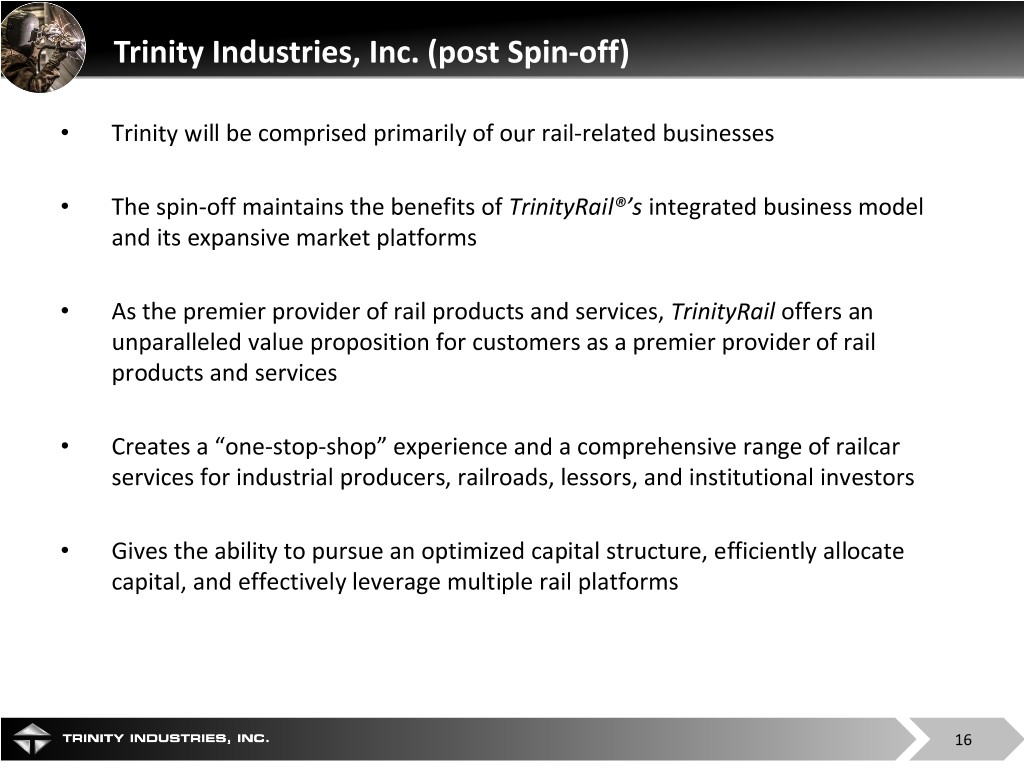
Trinity Industries, Inc. (post Spin-off) • Trinity will be comprised primarily of our rail-related businesses • The spin-off maintains the benefits of TrinityRail®’s integrated business model and its expansive market platforms • As the premier provider of rail products and services, TrinityRail offers an unparalleled value proposition for customers as a premier provider of rail products and services • Creates a “one-stop-shop” experience and a comprehensive range of railcar services for industrial producers, railroads, lessors, and institutional investors • Gives the ability to pursue an optimized capital structure, efficiently allocate capital, and effectively leverage multiple rail platforms 16
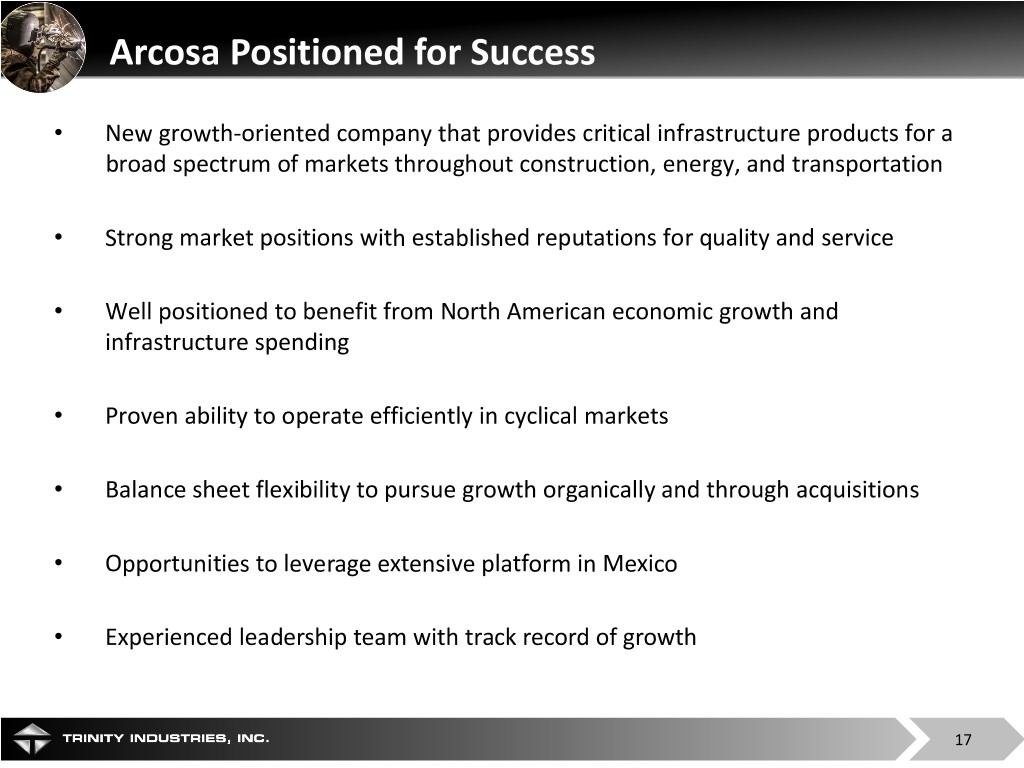
Arcosa Positioned for Success • New growth-oriented company that provides critical infrastructure products for a broad spectrum of markets throughout construction, energy, and transportation • Strong market positions with established reputations for quality and service • Well positioned to benefit from North American economic growth and infrastructure spending • Proven ability to operate efficiently in cyclical markets • Balance sheet flexibility to pursue growth organically and through acquisitions • Opportunities to leverage extensive platform in Mexico • Experienced leadership team with track record of growth 17

Trinity business segments (post spin-off) Trinity Industries, Inc. (post spin-off) 2017 Revenues: $2.4B1 Rail Leasing and Rail Group All Other Eliminations Management Services Group ($ Millions) 2017 Revenues 1 $2,044 $843 $344 ($834) ▪ Tank and freight railcars ▪ TrinityRail Leasing Services ▪ Highway Products ▪ Eliminations, primarily of sale of Businesses ▪ Maintenance Services ▪ Asset management ▪ Trinity Logistics Group railcars from Rail ▪ Railcar parts and heads 2 ▪ Railcar investment vehicle Manufacturing to Rail (RIV) sales Leasing 3 Please see Footnotes on Slides 30- 31. 18

Arcosa business segments Arcosa, Inc. (per Form 10 Filing) 2017 Revenues: $1.5B1 Transportation Products Energy Equipment Group Construction Products Group Group ($ Millions) 2017 Revenues $259 $844 $363 Natural aggregates (sand and Inland barges2 ▪ ▪ Wind towers ▪ Products gravel) ▪ Utility structures ▪ Fiberglass covers and other barge 2 ▪ Lightweight aggregates components ▪ Pressurized and non-pressurized ▪ Trench shields and shoring storage and distribution containers ▪ Axles & couplers 3 products ▪ Industrial and mining components 3 For more information refer to the Information Statement Summary section of the initial Form 10 filed on May 15, 2018, and subsequent amendments filed on June 15 and August 1, located at the Trinity Spin-off section of Trinity’s website, www.trin.net Please see Footnotes on Slides 30- 31. 19

III. Spin-off Timeline and Progress Report Announcement • Continued analysis and planning December 2017 • Refinement of new corporate and organizational structures • Initial Form 10 filed May 15, 2018; subsequent amendments filed on June 15 and August 1, 2018 • Organization preparation • IRS private letter ruling on tax-free status of transaction • Final approval by Board of Directors • Investor Day for both companies expected after declaration date for the distribution of Arcosa shares Expected • Distribution of Arcosa shares Completion Q4 2018 20
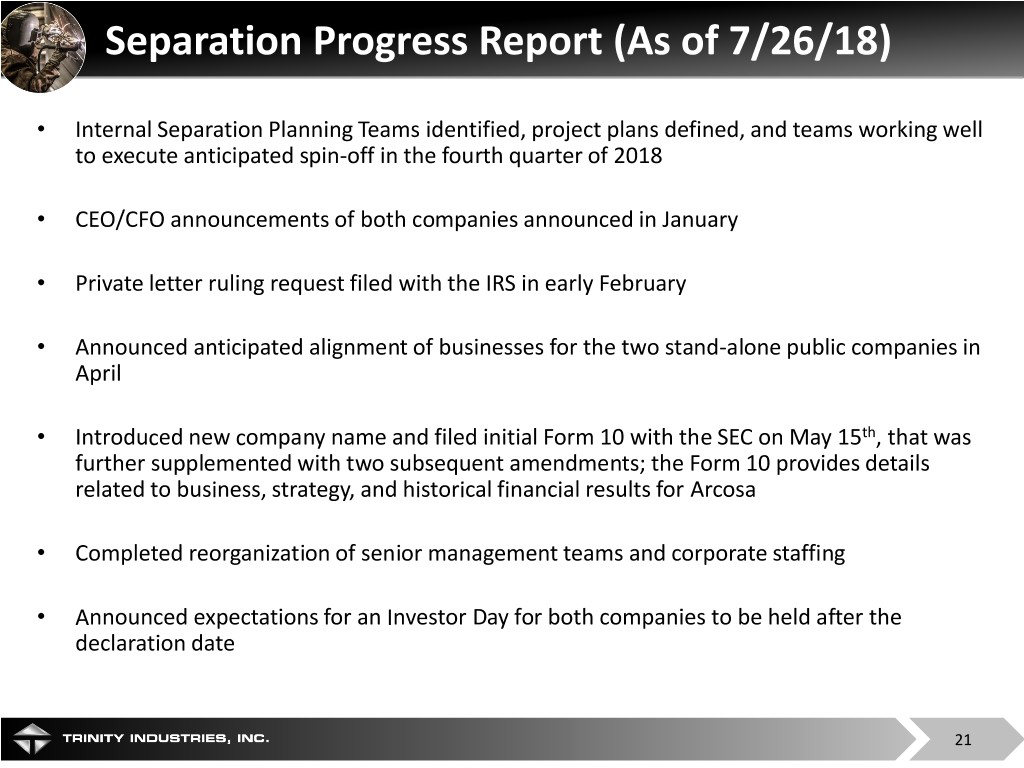
Separation Progress Report (As of 7/26/18) • Internal Separation Planning Teams identified, project plans defined, and teams working well to execute anticipated spin-off in the fourth quarter of 2018 • CEO/CFO announcements of both companies announced in January • Private letter ruling request filed with the IRS in early February • Announced anticipated alignment of businesses for the two stand-alone public companies in April • Introduced new company name and filed initial Form 10 with the SEC on May 15th, that was further supplemented with two subsequent amendments; the Form 10 provides details related to business, strategy, and historical financial results for Arcosa • Completed reorganization of senior management teams and corporate staffing • Announced expectations for an Investor Day for both companies to be held after the declaration date 21
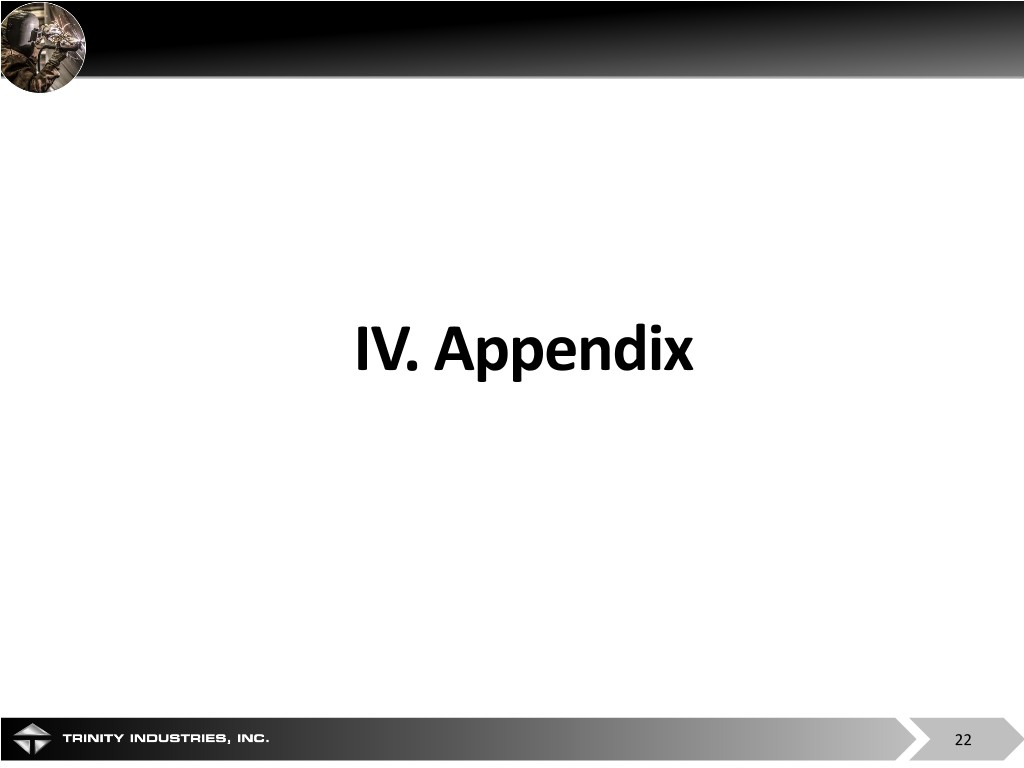
IV. Appendix 22
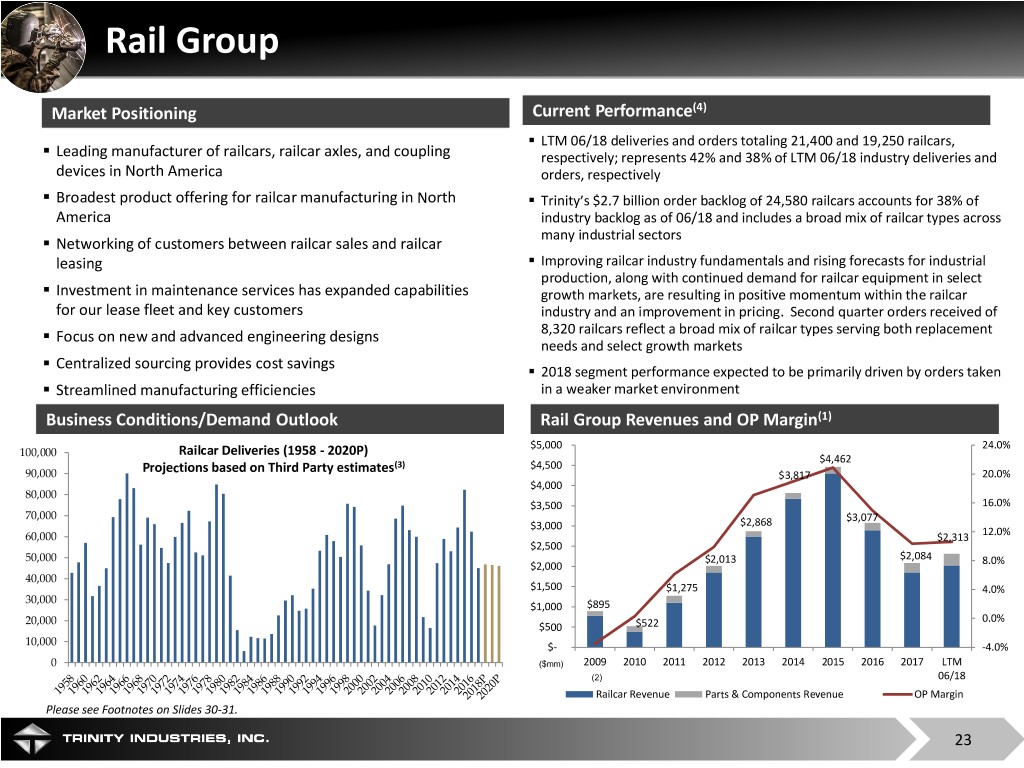
Rail Group Market Positioning Current Performance(4) . . LTM 06/18 deliveries and orders totaling 21,400 and 19,250 railcars, Leading manufacturer of railcars, railcar axles, and coupling respectively; represents 42% and 38% of LTM 06/18 industry deliveries and devices in North America orders, respectively . Broadest product offering for railcar manufacturing in North . Trinity’s $2.7 billion order backlog of 24,580 railcars accounts for 38% of America industry backlog as of 06/18 and includes a broad mix of railcar types across many industrial sectors . Networking of customers between railcar sales and railcar . leasing Improving railcar industry fundamentals and rising forecasts for industrial . production, along with continued demand for railcar equipment in select Investment in maintenance services has expanded capabilities growth markets, are resulting in positive momentum within the railcar for our lease fleet and key customers industry and an improvement in pricing. Second quarter orders received of . Focus on new and advanced engineering designs 8,320 railcars reflect a broad mix of railcar types serving both replacement needs and select growth markets . Centralized sourcing provides cost savings . 2018 segment performance expected to be primarily driven by orders taken . Streamlined manufacturing efficiencies in a weaker market environment (1) Business Conditions/Demand Outlook Rail Group Revenues and OP Margin $5,000 24.0% 100,000 Railcar Deliveries (1958 - 2020P) $4,462 Projections based on Third Party estimates(3) $4,500 90,000 $3,817 20.0% $4,000 80,000 $3,500 16.0% 70,000 $3,077 $3,000 $2,868 60,000 $2,313 12.0% $2,500 50,000 $2,013 $2,084 8.0% $2,000 40,000 $1,500 $1,275 4.0% 30,000 $1,000 $895 20,000 0.0% $500 $522 10,000 $- -4.0% 0 ($mm) 2009 2010 2011 2012 2013 2014 2015 2016 2017 LTM (2) 06/18 Railcar Revenue Parts & Components Revenue OP Margin Please see Footnotes on Slides 30-31. 23
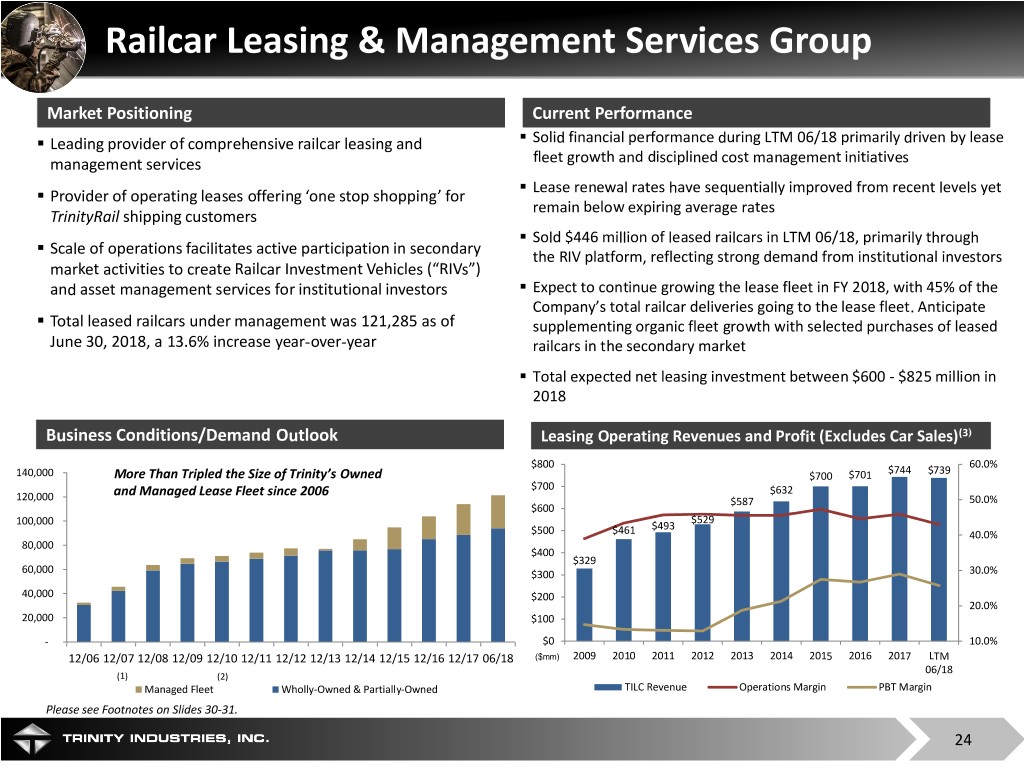
Railcar Leasing & Management Services Group Market Positioning Current Performance . . Leading provider of comprehensive railcar leasing and Solid financial performance during LTM 06/18 primarily driven by lease management services fleet growth and disciplined cost management initiatives . Lease renewal rates have sequentially improved from recent levels yet . Provider of operating leases offering ‘one stop shopping’ for remain below expiring average rates TrinityRail shipping customers . . Sold $446 million of leased railcars in LTM 06/18, primarily through Scale of operations facilitates active participation in secondary the RIV platform, reflecting strong demand from institutional investors market activities to create Railcar Investment Vehicles (“RIVs”) . and asset management services for institutional investors Expect to continue growing the lease fleet in FY 2018, with 45% of the . Company’s total railcar deliveries going to the lease fleet. Anticipate Total leased railcars under management was 121,285 as of supplementing organic fleet growth with selected purchases of leased June 30, 2018, a 13.6% increase year-over-year railcars in the secondary market . Total expected net leasing investment between $600 - $825 million in 2018 Business Conditions/Demand Outlook Leasing Operating Revenues and Profit (Excludes Car Sales)(3) $800 60.0% $744 $739 140,000 More Than Tripled the Size of Trinity’s Owned $700 $701 and Managed Lease Fleet since 2006 $700 $632 120,000 $587 50.0% $600 $529 100,000 $493 $500 $461 40.0% 80,000 $400 $329 60,000 $300 30.0% 40,000 $200 20.0% 20,000 $100 - $0 10.0% 12/06 12/07 12/08 12/09 12/10 12/11 12/12 12/13 12/14 12/15 12/16 12/17 06/18 ($mm) 2009 2010 2011 2012 2013 2014 2015 2016 2017 LTM 06/18 (1) (2) Managed Fleet Wholly-Owned & Partially-Owned TILC Revenue Operations Margin PBT Margin Please see Footnotes on Slides 30-31. 24

Construction Products Group Market Positioning Current Performance . . Leading U.S. manufacturer of highway guardrail, crash LTM 06/18 revenues increased primarily due to higher volumes in our cushions, and other protective barriers construction aggregates businesses and other businesses. The increase in revenues from our other businesses was primarily a result . Leading producer and distributor of lightweight and of our trench shoring acquisition natural construction aggregates in certain regions in the . Operating margin remains above recent historical levels and reflects United States the repositioning of the business portfolio to align with more . consistent demand drivers Diversified exposure to commercial, residential, industrial, . and highway markets During 2017, we completed $63 million in acquisitions, expanding our trench shoring manufacturing platform and acquiring the assets of . Demand tied to the North American infrastructure build two lightweight aggregates businesses out and federal funding . Since 2013, exited the concrete and galvanizing businesses, entered and expanded the lightweight aggregates and trench shoring products businesses, and continued to invest in the Company’s natural aggregates platform Business Conditions/Demand Outlook Construction Products Group Revenues and OP Margin(1) . These businesses are well-positioned to benefit from long- $600 16.0% $552 $533 $531 $525 $523 term spending for replacement and growing infrastructure $484 $505 15.0% $500 needs in the U.S. $453 14.0% 13.0% $400 $354 . 12.0% Fixing America’s Surface Transportation ACT (FAST), passed $281 $300 11.0% in December 2015, authorized a $305 billion five-year 10.0% funding bill for highways and other related transit $200 9.0% programs, providing much needed stability for public $100 8.0% agencies charged with planning transportation projects 7.0% $0 6.0% . ($mm) 2009 2010 2011 2012 2013 2014 2015 2016 2017 LTM Strong demand for aggregates in the southwestern U.S. (2) 06/18 market due to residential and non-residential investment Highway Products Aggregates Other OP Margin Please see Footnotes on Slides 30-31. 25
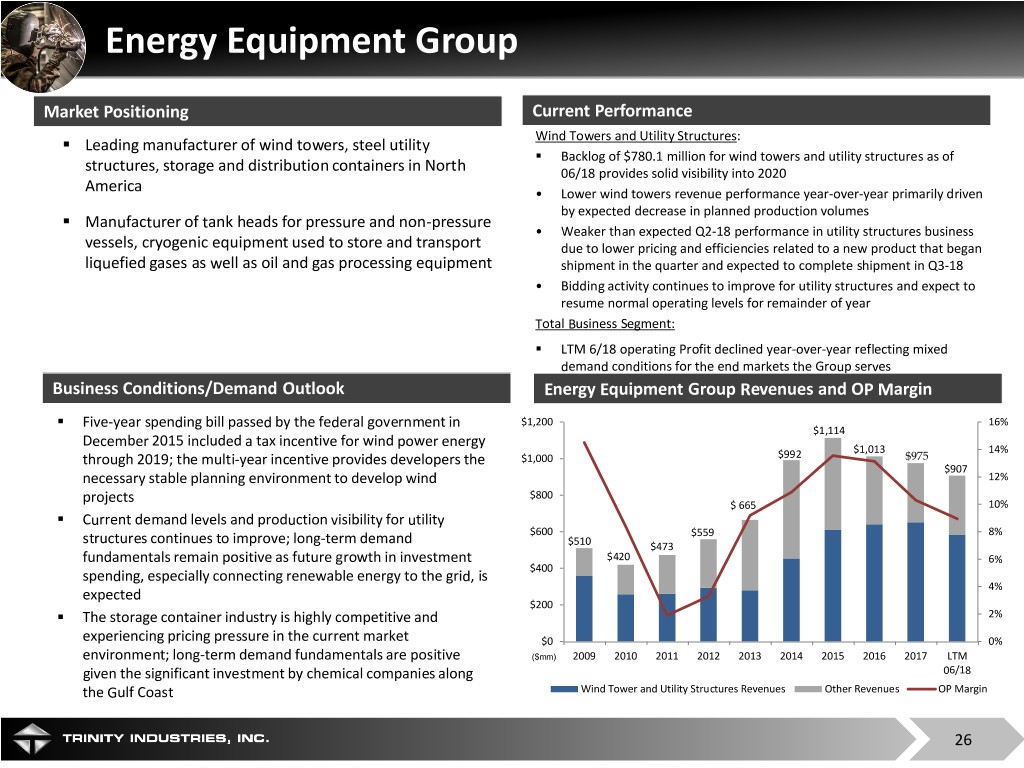
Energy Equipment Group Market Positioning Current Performance Wind Towers and Utility Structures: . Leading manufacturer of wind towers, steel utility . Backlog of $780.1 million for wind towers and utility structures as of structures, storage and distribution containers in North 06/18 provides solid visibility into 2020 America • Lower wind towers revenue performance year-over-year primarily driven by expected decrease in planned production volumes . Manufacturer of tank heads for pressure and non-pressure • Weaker than expected Q2-18 performance in utility structures business vessels, cryogenic equipment used to store and transport due to lower pricing and efficiencies related to a new product that began liquefied gases as well as oil and gas processing equipment shipment in the quarter and expected to complete shipment in Q3-18 • Bidding activity continues to improve for utility structures and expect to resume normal operating levels for remainder of year Total Business Segment: . LTM 6/18 operating Profit declined year-over-year reflecting mixed demand conditions for the end markets the Group serves Business Conditions/Demand Outlook Energy Equipment Group Revenues and OP Margin . Five-year spending bill passed by the federal government in $1,200 16% $1,114 December 2015 included a tax incentive for wind power energy $1,013 14% through 2019; the multi-year incentive provides developers the $1,000 $992 $975 $907 necessary stable planning environment to develop wind 12% projects $800 $ 665 10% . Current demand levels and production visibility for utility structures continues to improve; long-term demand $600 $559 8% $510 $473 fundamentals remain positive as future growth in investment $420 6% $400 spending, especially connecting renewable energy to the grid, is 4% expected $200 . The storage container industry is highly competitive and 2% experiencing pricing pressure in the current market $0 0% environment; long-term demand fundamentals are positive ($mm) 2009 2010 2011 2012 2013 2014 2015 2016 2017 LTM given the significant investment by chemical companies along 06/18 the Gulf Coast Wind Tower and Utility Structures Revenues Other Revenues OP Margin 26

Inland Barge Group Market Positioning Current Performance . . Revenues and profit down significantly again in LTM 06/18 versus Leading manufacturer of inland barges and fiberglass barge recent historic levels due to a substantial decline in barge covers in the United States deliveries and a weak pricing environment . . Multiple barge manufacturing facilities on inland waterways Backlog increased from $198.4 million at June 30, 2018 compared enable rapid delivery to $90.7 million at June 30,2017 primarily due to increase in order activity for liquid barges through the first half of the year . Operating flexibility is a key differentiator . Continue to remain focused on cost initiatives as barges expected . Barge transportation has a cost advantage in high-cost fuel to produce in second half of 2018 were priced in a highly environments competitive market . Expect a higher level of changeovers in second half of the year to meet certain barge types and prepare for 2019 production plans Business Conditions/Demand Outlook Inland Barge Group Revenues and OP Margin . Improving utilization rates, level of retirements vs. build, and liquid $800 24% barge movements are helping balance supply and demand; $700 $675 $653 21% customers are cautiously optimistic regarding improving $639 fundamentals, but too early to determine if sustained recovery $600 $577 18% $527 $549 Replacement demand driver (as of 03/31/18):(4) $500 15% . 3,906 out of 18,819 hopper barges, or approximately 20.8%, are $422 $403 $400 12% greater than 20 years old $300 9% . 840 out of 3,617 tank barges, or approximately 23.2%, are greater than 20 years old $200 $158 6% $135 . From 2000 to 2017, the industry had a build-to-scrap ratio of 0.9x; in $100 3% 2017 the ratio was 0.5x $0 0% 2009 2010 2011 2012 2013 2014 2015 2016 2017 LTM ($mm) (1) (2) (3) 06/18 Revenues OP Margin Please see Footnotes on Slides 30-31. 27

Reconciliation of EBITDA (1)(2) (in millions) 2009 2010 2011 2012 2013 2014 2015 2016 2017 LTM 06/18 Income (loss) from continuing operations ($140.8) $69.4 $146.8 $251.9 $386.1 $709.3 $826.0 $364.7 $713.6 $715.0 Add: Interest expense 123.1 182.1 185.3 194.7 187.3 193.4 194.7 181.9 184.0 183.4 Provision/(Benefit) for income taxes (11.5) 37.3 92.2 134.0 204.4 354.8 426.0 202.1 (341.6) (364.3) Depreciation & amortization expense 147.1 180.9 187.7 193.7 211.5 244.6 266.4 283.0 295.4 301.5 Goodwill impairment 325.0 - - - - - - - - - Earnings from continuing operations before interest expense, income taxes, and depreciation and amortization expense $442.9 $469.7 $612.0 $774.3 $989.3 $1,502.1 $1,713.1 $1,031.7 $851.4 $835.6 “EBITDA” is defined as income (loss) from continuing operations plus interest expense, income taxes, and depreciation and amortization including goodwill impairment charges. EBITDA is not a calculation based on generally accepted accounting principles. The amounts included in the EBITDA calculation, however, are derived from amounts included in the historical statements of operations data. In addition, EBITDA should not be considered as an alternative to net income or operating income as an indicator of our operating performance, or as an alternative to operating cash flows as a measure of liquidity. We believe EBITDA assists investors in comparing a company’s performance on a consistent basis without regard to depreciation and amortization, which can vary significantly depending upon many factors. However, the EBITDA measure presented in this presentation may not always be comparable to similarly titled measures by other companies due to differences in the components of the calculation. (1) EBITDA for previous years has been adjusted as a result of the divestiture of the Company’s Concrete business (2) Includes results of operations related to TRIP starting January 1, 2010 28
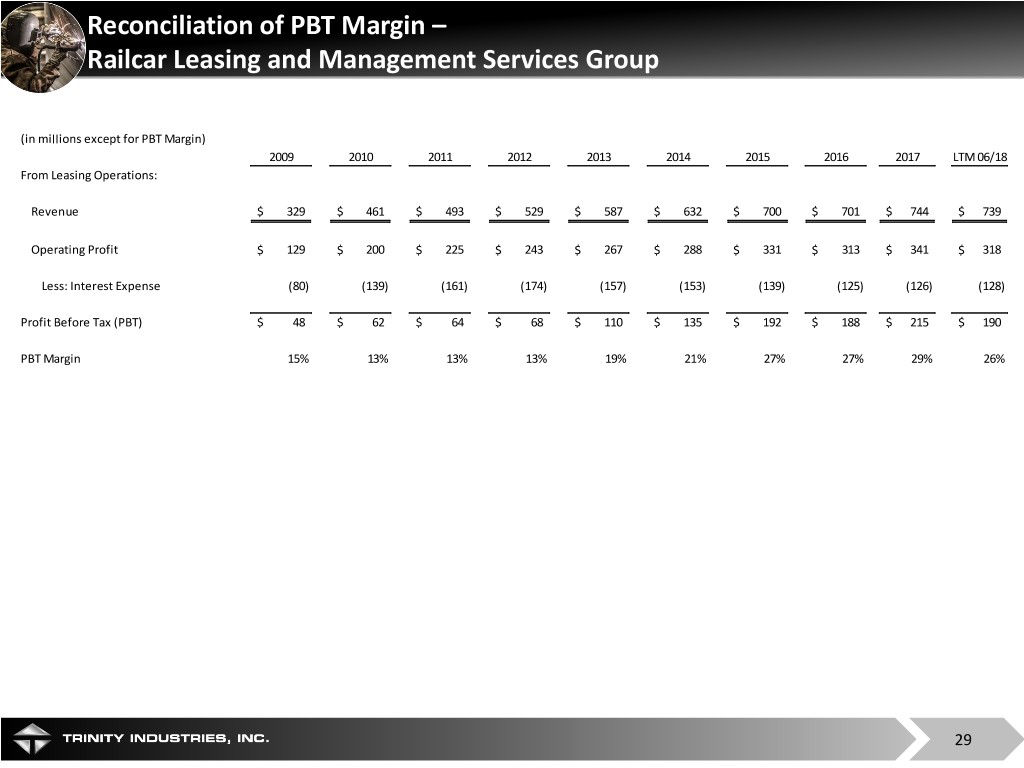
Reconciliation of PBT Margin – Railcar Leasing and Management Services Group (in millions except for PBT Margin) 2009 2010 2011 2012 2013 2014 2015 2016 2017 LTM 06/18 From Leasing Operations: Revenue $ 329 $ 461 $ 493 $ 529 $ 587 $ 632 $ 700 $ 701 $ 744 $ 739 Operating Profit $ 129 $ 200 $ 225 $ 243 $ 267 $ 288 $ 331 $ 313 $ 341 $ 318 Less: Interest Expense (80) (139) (161) (174) (157) (153) (139) (125) (126) (128) Profit Before Tax (PBT) $ 48 $ 62 $ 64 $ 68 $ 110 $ 135 $ 192 $ 188 $ 215 $ 190 PBT Margin 15% 13% 13% 13% 19% 21% 27% 27% 29% 26% 29

Footnotes Slide 4 (1) Intersegment Revenues are eliminated and Leasing Revenues include revenues related to TRIP Holdings beginning in FY 2010; CPG Revenues for prior years have also been adjusted as a result of the divestiture of its Concrete business in March 2013 (2) FY 2009 EPS excludes a $325 million pretax Goodwill impairment amounting to $1.57 per share; reported FY 2009 EPS was $(0.91) (3) FY 2017 and LTM 06/18 exclude $476 million non-cash tax benefit related to the effects of the Tax Cuts and Jobs Act. Approximately, $14 million and $32.3 million of spin-off related transaction costs were also excluded for 2017 and LTM 06/18, respectively Slide 6 (1) Operating Profit Excludes All Other, Corporate and is reduced by Leasing Interest Expense of $7 million in FY 2000 and $127.7 million in LTM 06/18 (2) Rail percentage represents Operating Profit less all Intersegment Company Eliminations; Leasing percentage represents Operating Profit less Leasing Interest Expense (3) FY 2009 EPS excludes a $325 million pretax Goodwill impairment amounting to $1.57 per share; reported FY 2009 EPS was $(0.91) (4) FY 2017 and LTM 06/18 exclude $476 million non-cash tax benefit related to the effects of the Tax Cuts and Jobs Act. Approximately, $14 million and $32.3 million of spin-off related transaction costs were also excluded for 2017 and LTM 06/18, respectively Slide 9 (1) Excludes unamortized discount and/or unamortized debt issuance costs (2) Leasing railcar equipment has a net book value of $6.4 billion, excluding deferred profit and including partially-owned subsidiaries Slide 10 (1) LTM 06/18 vs LTM 06/17, all numbers on a Continuing Operations basis except for EPS, which reflects Total Company EPS (2) Operating Profit includes Leasing Interest Expense (3) EPS is for Total Company, including Discontinued Operations; LTM 06/18 per share amount consists of sum of individual quarters (4) Excludes $325 million pre-tax impact of impairment of Goodwill amounting to $1.57 per share; reported FY 2009 EPS was $(0.91) (5) FY 2017 and LTM 06/18 exclude $476 million non-cash tax benefit related to the effects of the Tax Cuts and Jobs Act. Spin-off related transaction costs of approximately $14 million and $32.3 million were also excluded for 2017 and LTM 06/18, respectively (6) See Note in Appendix pg. 28 for Reconciliation of EBITDA; EBITDA for previous years has been adjusted as a result of the divestiture of the Company’s Concrete business Slide 18 (1) Revenues are unaudited and are based on management’s estimates and assumptions and include All Other and Revenue Eliminations post spin-off (2) For financial reporting purposes, a portion of this business (heads product line) is currently included within the financial results of the Energy Equipment Group, but will be retained by Trinity Industries, Inc. following the spin-off (3) Eliminations include manufactured railcars sold to the leasing company Slide 19 (1) Revenues exclude All Other and Revenue Eliminations as provided in the initial Form 10 of Arcosa, Inc. filed May 15, 2018. Unaudited Pro-Forma adjustments have not been included (2) For financial reporting purposes, the results of operations of Inland Barge and its related components are currently reported as a separate segment by Trinity Industries, Inc. (3) For financial reporting purposes, the results of operations of the Components business, including axles and couplers, is currently included with the results of operations of the Rail Group by Trinity Industries, Inc. but will be included with the results of operations of the Transportation Products Group of Arcosa, Inc. following the spin-off 30
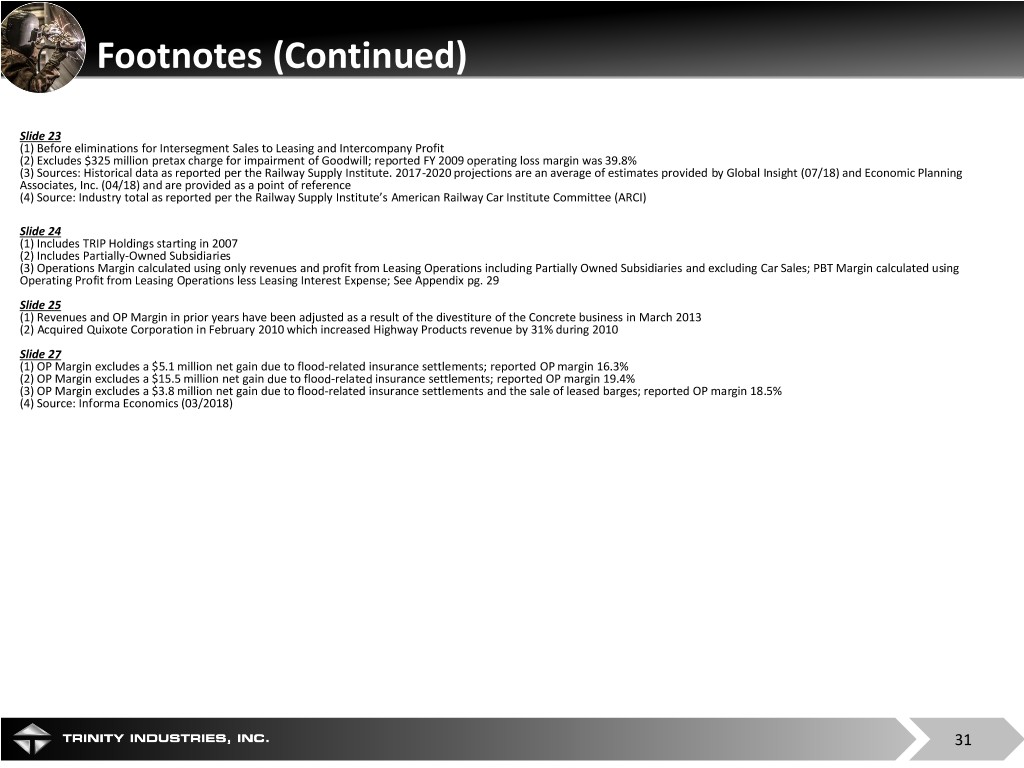
Footnotes (Continued) Slide 23 (1) Before eliminations for Intersegment Sales to Leasing and Intercompany Profit (2) Excludes $325 million pretax charge for impairment of Goodwill; reported FY 2009 operating loss margin was 39.8% (3) Sources: Historical data as reported per the Railway Supply Institute. 2017-2020 projections are an average of estimates provided by Global Insight (07/18) and Economic Planning Associates, Inc. (04/18) and are provided as a point of reference (4) Source: Industry total as reported per the Railway Supply Institute’s American Railway Car Institute Committee (ARCI) Slide 24 (1) Includes TRIP Holdings starting in 2007 (2) Includes Partially-Owned Subsidiaries (3) Operations Margin calculated using only revenues and profit from Leasing Operations including Partially Owned Subsidiaries and excluding Car Sales; PBT Margin calculated using Operating Profit from Leasing Operations less Leasing Interest Expense; See Appendix pg. 29 Slide 25 (1) Revenues and OP Margin in prior years have been adjusted as a result of the divestiture of the Concrete business in March 2013 (2) Acquired Quixote Corporation in February 2010 which increased Highway Products revenue by 31% during 2010 Slide 27 (1) OP Margin excludes a $5.1 million net gain due to flood-related insurance settlements; reported OP margin 16.3% (2) OP Margin excludes a $15.5 million net gain due to flood-related insurance settlements; reported OP margin 19.4% (3) OP Margin excludes a $3.8 million net gain due to flood-related insurance settlements and the sale of leased barges; reported OP margin 18.5% (4) Source: Informa Economics (03/2018) 31
